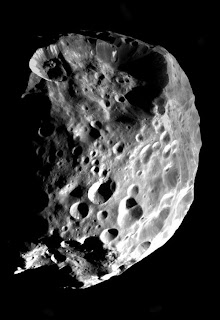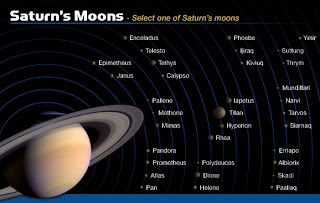Explaining Phoebe: not hard, but not relevant

In James Randi's commentary for today he quotes an email he received from a reader; an excerpt follows here:
Reader: While "Google-Earthing," looking at places in the US of geological interest, I happened upon a link added to GoogleEarth: www.creationscience.com. I guess this site is pretty familiar to you? Just for fun, I had a look at the site, and in a few seconds I found these preposterous statements in their astro/physics section, here with my remarks:
Saturn has 33 known moons. One of them, named Phoebe, has an orbit almost perpendicular to Saturn’s equator. This is difficult for evolutionists to explain.
Reader: Creationists make it really simple: "It was created thus..."
Randi: No, only 19, but with lots of smaller orbiting chunks. And there is no difficulty at all providing excellent explanations for this oblique orbit! Does the Bible offer any evidence on this…?
You know what? Randi's right - like it makes any difference.
 Well, Randi's right with a quibble. Some people (Randi obviously among them) object to calling something a "moon" when it's small. Lots of Saturn's satellites are less than 10 kilometers across. Phoebe is roughly spherical and some 220 kilometers in diameter and is "substantially larger than any of the other moons orbiting planets at comparable distances", as its Wikipedia entry puts it. It's those little moons - too small to be seen until a spacecraft goes past - that Randi calls "smaller orbiting chunks;" some folks call them "moonlets" while others, including JPL and the Cassini-Huygens team, give the name moon even to "tiny Polydeuces, a moon that was discovered by the Cassini spacecraft and is a mere 3 kilometers (2 miles) across". So 33 or 19 moons is a matter of taste. On this one, I go with creationscience.com, myself - though they are a bit behind the times - as the JPL Cassini-Huygens site says, "So far, 35 of Saturn's moons have been named."
Well, Randi's right with a quibble. Some people (Randi obviously among them) object to calling something a "moon" when it's small. Lots of Saturn's satellites are less than 10 kilometers across. Phoebe is roughly spherical and some 220 kilometers in diameter and is "substantially larger than any of the other moons orbiting planets at comparable distances", as its Wikipedia entry puts it. It's those little moons - too small to be seen until a spacecraft goes past - that Randi calls "smaller orbiting chunks;" some folks call them "moonlets" while others, including JPL and the Cassini-Huygens team, give the name moon even to "tiny Polydeuces, a moon that was discovered by the Cassini spacecraft and is a mere 3 kilometers (2 miles) across". So 33 or 19 moons is a matter of taste. On this one, I go with creationscience.com, myself - though they are a bit behind the times - as the JPL Cassini-Huygens site says, "So far, 35 of Saturn's moons have been named."Now, as for Phoebe and its orbit.
For more than 100 years, Phoebe was Saturn's outermost known moon, until the discovery of several smaller moons in 2000. It is one of the "Norse group" of Saturn's moons: eighteen irregular retrograde outer moons that are similar enough in their distance from Saturn to be considered a group. The others are Skathi, Narvi, Mundilfari, Suttungr, Thrymr, Ymir, and a bunch of as-yet-unnamed moons discovered in 2004 and 2006. In fact, other than Phoebe, none of these moons were found earlier than 2000 - Phoebe was actually discovered in 1899 by William Henry Pickering from photographic plates that had been taken at Arequipa, Peru, by DeLisle Stewart. (It was the first satellite to be discovered photographically.) This accounts for Phoebe's odd-man-out status in the naming, by the way.
Phoebe is, judging by the fabulous photos sent back by Cassini, an old body, repeatedly battered by collisions. Some of its craters are three and four times wider than its little Norse-named companions, and there's speculation that they may be actual chunks of Phoebe that have been knocked into their own irregular (or eccentric) orbits by those collisions.
Phoebe is roughly spherical and rotates on its axis every nine hours. Its irregular, elliptical orbit is inclined about 30 degrees to Saturn's equator. Phoebe's orbit is also retrograde, which means it goes around Saturn the opposite direction than most other moons -- as well as most objects in the solar system.Hmmm... "inclined about 30 degrees to Saturn's equator" doesn't sound like "almost perpendicular to Saturn’s equator" to me. I think the creationscience.com guys got confused by the 151.66° inclination label found in many sources - for a satellite in a retrograde orbit, this is equivalent to 30° (well, to 28.44°, anyway) for one in a prograde orbit, as they'd know if they read up what these terms mean. Above 30° (or below 150° for retrograde orbits) and the orbit isn't stable; the satellite either drifts away from the planet (prograde) or crashes into it (retrograde). But because the acceleration is aimed inwards with retrograde motion, such satellites can be much further away and remain in stable orbits than can their 'forward' siblings.Unlike most major moons orbiting Saturn, Phoebe is very dark and reflects only 6 percent of the sunlight it receives. Its darkness and irregular, retrograde orbit suggest Phoebe is most likely a captured object, which is a celestial body that is trapped by the gravitational pull of a much bigger body, generally a planet. Phoebe may come from the outer solar system -- an area where there is plenty of dark material.
Some scientists think Phoebe could be a captured Centaur. Centaurs are believed to be Kuiper Belt bodies that migrated into the inner solar system. Centaurs are found between the asteroid belt and the Kuiper Belt, and are considered a kind of intermediate type of small body, neither an asteroid nor a Kuiper Belt object.
So, first off, Phoebe isn't "almost perpendicular to Saturn's equator", so that doesn't need explaining. Everything else about Phoebe's orbit can be explained with, as Randi said, "no difficulty at all" - captured bodies have inclined, retrograde orbits because that's how the physics works out. We know it, we can predict we'll find such moons (and then we do, cool!), and we can easily explain the mechanics.
What gets me is this: "This is difficult for evolutionists to explain."
For evolutionists?
See, I don't think they mean that evolutionary biologists aren't up in celestial mechanics and have a hard time explaining such things. I think they mean that evolution has something to do with celestial mechanics and moon-planet dynamics and the like.
Guys: evolution deals with living things. Whether "Darwinism" or the modern synthesis can explain why some moons have inclined, retrograde orbits at great distances from their planets has nothing whatsoever to do with either the moons or evolution. Don't the guys at creationscience.com think they'd be better off asking astronomers about Phoebe's orbit, and "evolutionists" about, oh, evolution?
Of course not. Because their purpose is to pretend that there are great questions out there that "evolutionists" cannot answer, questions that can only be answered "It was created thus" - meaning "God did it." And implying "So shut up, sit down, and stop asking."
It would be nice to think that if one of them ran into an "evolutionist" who answered their question about Phoebe's orbit - and all the rest of the questions there - that they'd reassess their position. As Aleksandr Arkhangelsky said, about something very different, Na chto i nadezhda - that's where our hope is.
But experience tells us different. Because such questions? They're not that hard to answer.
Labels: evolution, freethought, links, science


























2 Comments:
-
At 2:28 PM, February 23, 2007
 Barry Leiba had this to say...
Barry Leiba had this to say...
-
-
At 5:11 PM, February 24, 2007
 The Ridger, FCD had this to say...
The Ridger, FCD had this to say...
-
-
<-- Older Post ^ Home Newer Post -->Yeah, I, too, wondered what on Earth (sorry; what on Saturn) it had to do with evolution. [[shrug]]
Ah, and I remember when I was young and foolish, and we thought there were 31 moons... in the whole solar system (and (ahem) I could name them all).
There does have to be some limit, though, on what we consider to be a "moon", as opposed to a "chunk". Otherwise, all the bits of ring matter would have to be considered as some 17 million Saturnian moons. (As it is, I guess we can say that Saturn blew chunks. Or something like that....)
If anybody asks me, I think if it's big enough to park a spaceship on and orbits the planet by itself, it's a moon.
But then, I think anything that's basically spherical, orbits the sun, and has its own moon, it's a planet ... and you see what happened to Pluto - Charon, Nix, and Hydra notwithstanding.
Post a Comment
Subscribe to Post Comments [Atom]